Blockchain Technology: Security, Applications, and Future Trends
VerifiedAdded on 2023/01/11
|11
|3316
|86
Report
AI Summary
This report provides a comprehensive overview of blockchain technology, encompassing its fundamental concepts, operational mechanisms, and diverse applications. It delves into the core components of blockchain, including the structure of blocks, transaction processes, and the role of hashing techniques in ensuring data integrity. The report examines how blockchain achieves Confidentiality, Integrity, and Availability (CIA), crucial for secure data management. Furthermore, it explores various applications of blockchain, such as digital IDs, digital voting, and immutable data backup systems, highlighting their potential to revolutionize industries. The report also analyzes the capabilities and limitations of blockchain technology, assessing its impact on different sectors, particularly the banking industry, and projecting its future trends. The content is contributed by a student to be published on the website Desklib. Desklib is a platform which provides all the necessary AI based study tools for students.

Report
Paraphrase This Document
Need a fresh take? Get an instant paraphrase of this document with our AI Paraphraser
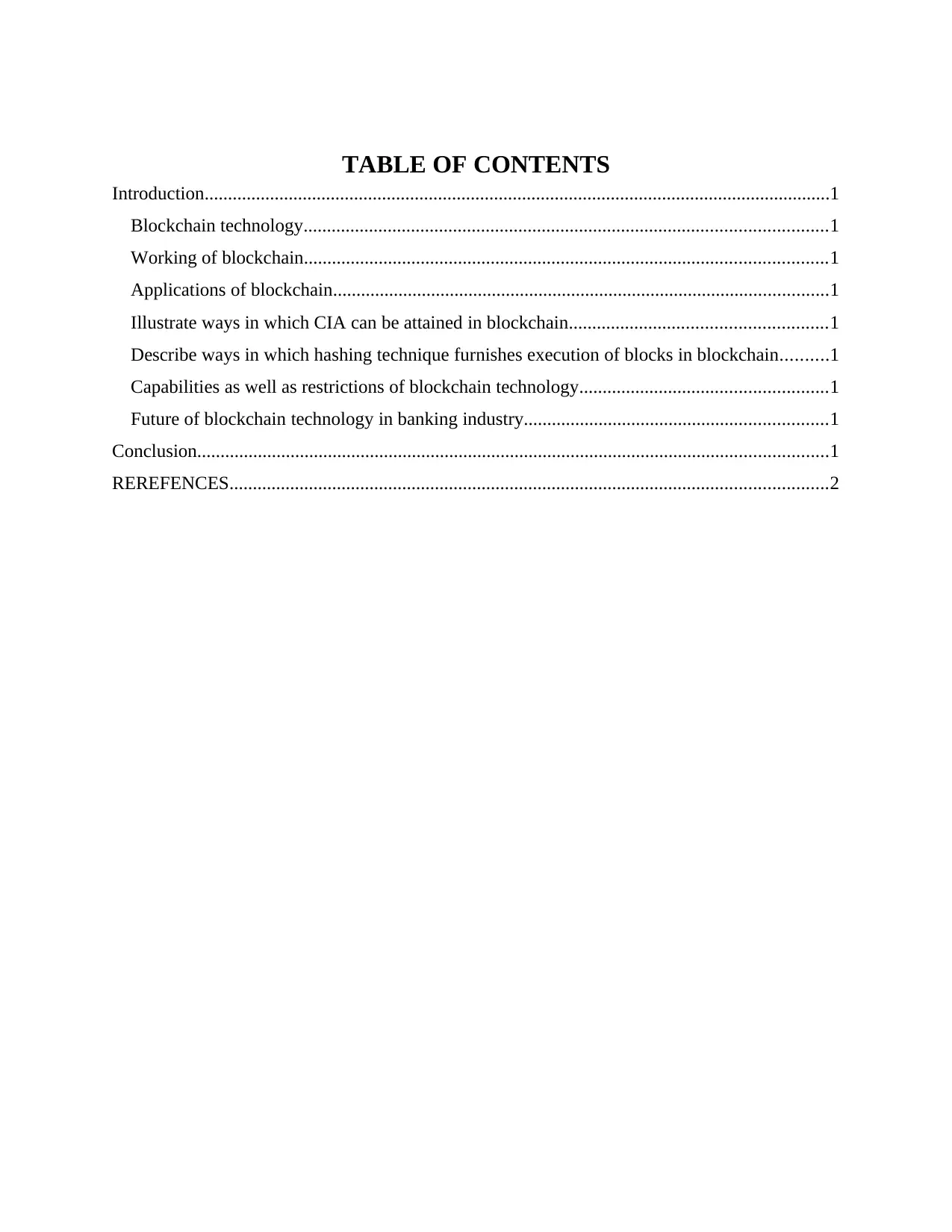
TABLE OF CONTENTS
Introduction......................................................................................................................................1
Blockchain technology................................................................................................................1
Working of blockchain................................................................................................................1
Applications of blockchain..........................................................................................................1
Illustrate ways in which CIA can be attained in blockchain.......................................................1
Describe ways in which hashing technique furnishes execution of blocks in blockchain..........1
Capabilities as well as restrictions of blockchain technology.....................................................1
Future of blockchain technology in banking industry.................................................................1
Conclusion.......................................................................................................................................1
REREFENCES................................................................................................................................2
Introduction......................................................................................................................................1
Blockchain technology................................................................................................................1
Working of blockchain................................................................................................................1
Applications of blockchain..........................................................................................................1
Illustrate ways in which CIA can be attained in blockchain.......................................................1
Describe ways in which hashing technique furnishes execution of blocks in blockchain..........1
Capabilities as well as restrictions of blockchain technology.....................................................1
Future of blockchain technology in banking industry.................................................................1
Conclusion.......................................................................................................................................1
REREFENCES................................................................................................................................2
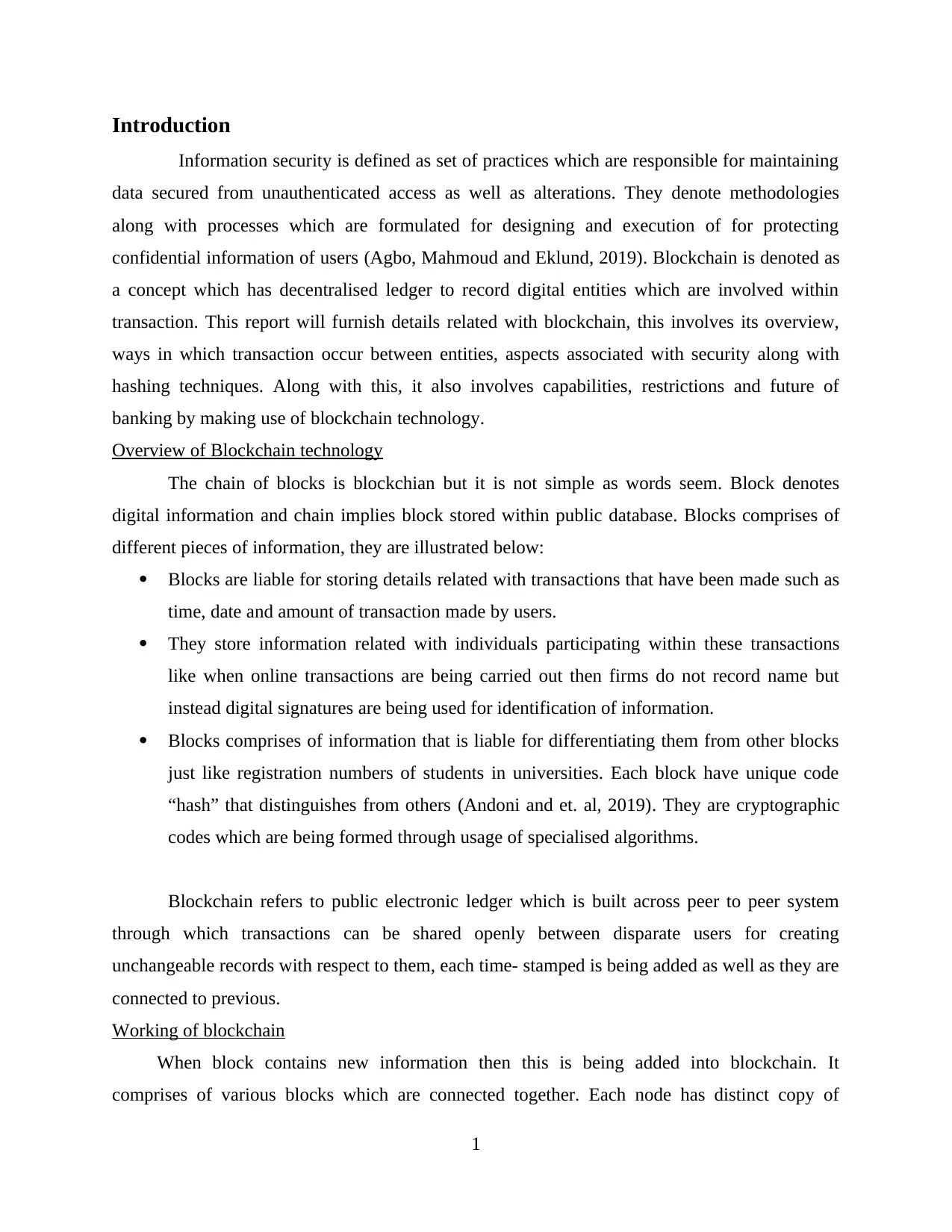
Introduction
Information security is defined as set of practices which are responsible for maintaining
data secured from unauthenticated access as well as alterations. They denote methodologies
along with processes which are formulated for designing and execution of for protecting
confidential information of users (Agbo, Mahmoud and Eklund, 2019). Blockchain is denoted as
a concept which has decentralised ledger to record digital entities which are involved within
transaction. This report will furnish details related with blockchain, this involves its overview,
ways in which transaction occur between entities, aspects associated with security along with
hashing techniques. Along with this, it also involves capabilities, restrictions and future of
banking by making use of blockchain technology.
Overview of Blockchain technology
The chain of blocks is blockchian but it is not simple as words seem. Block denotes
digital information and chain implies block stored within public database. Blocks comprises of
different pieces of information, they are illustrated below:
Blocks are liable for storing details related with transactions that have been made such as
time, date and amount of transaction made by users.
They store information related with individuals participating within these transactions
like when online transactions are being carried out then firms do not record name but
instead digital signatures are being used for identification of information.
Blocks comprises of information that is liable for differentiating them from other blocks
just like registration numbers of students in universities. Each block have unique code
“hash” that distinguishes from others (Andoni and et. al, 2019). They are cryptographic
codes which are being formed through usage of specialised algorithms.
Blockchain refers to public electronic ledger which is built across peer to peer system
through which transactions can be shared openly between disparate users for creating
unchangeable records with respect to them, each time- stamped is being added as well as they are
connected to previous.
Working of blockchain
When block contains new information then this is being added into blockchain. It
comprises of various blocks which are connected together. Each node has distinct copy of
1
Information security is defined as set of practices which are responsible for maintaining
data secured from unauthenticated access as well as alterations. They denote methodologies
along with processes which are formulated for designing and execution of for protecting
confidential information of users (Agbo, Mahmoud and Eklund, 2019). Blockchain is denoted as
a concept which has decentralised ledger to record digital entities which are involved within
transaction. This report will furnish details related with blockchain, this involves its overview,
ways in which transaction occur between entities, aspects associated with security along with
hashing techniques. Along with this, it also involves capabilities, restrictions and future of
banking by making use of blockchain technology.
Overview of Blockchain technology
The chain of blocks is blockchian but it is not simple as words seem. Block denotes
digital information and chain implies block stored within public database. Blocks comprises of
different pieces of information, they are illustrated below:
Blocks are liable for storing details related with transactions that have been made such as
time, date and amount of transaction made by users.
They store information related with individuals participating within these transactions
like when online transactions are being carried out then firms do not record name but
instead digital signatures are being used for identification of information.
Blocks comprises of information that is liable for differentiating them from other blocks
just like registration numbers of students in universities. Each block have unique code
“hash” that distinguishes from others (Andoni and et. al, 2019). They are cryptographic
codes which are being formed through usage of specialised algorithms.
Blockchain refers to public electronic ledger which is built across peer to peer system
through which transactions can be shared openly between disparate users for creating
unchangeable records with respect to them, each time- stamped is being added as well as they are
connected to previous.
Working of blockchain
When block contains new information then this is being added into blockchain. It
comprises of various blocks which are connected together. Each node has distinct copy of
1
⊘ This is a preview!⊘
Do you want full access?
Subscribe today to unlock all pages.

Trusted by 1+ million students worldwide
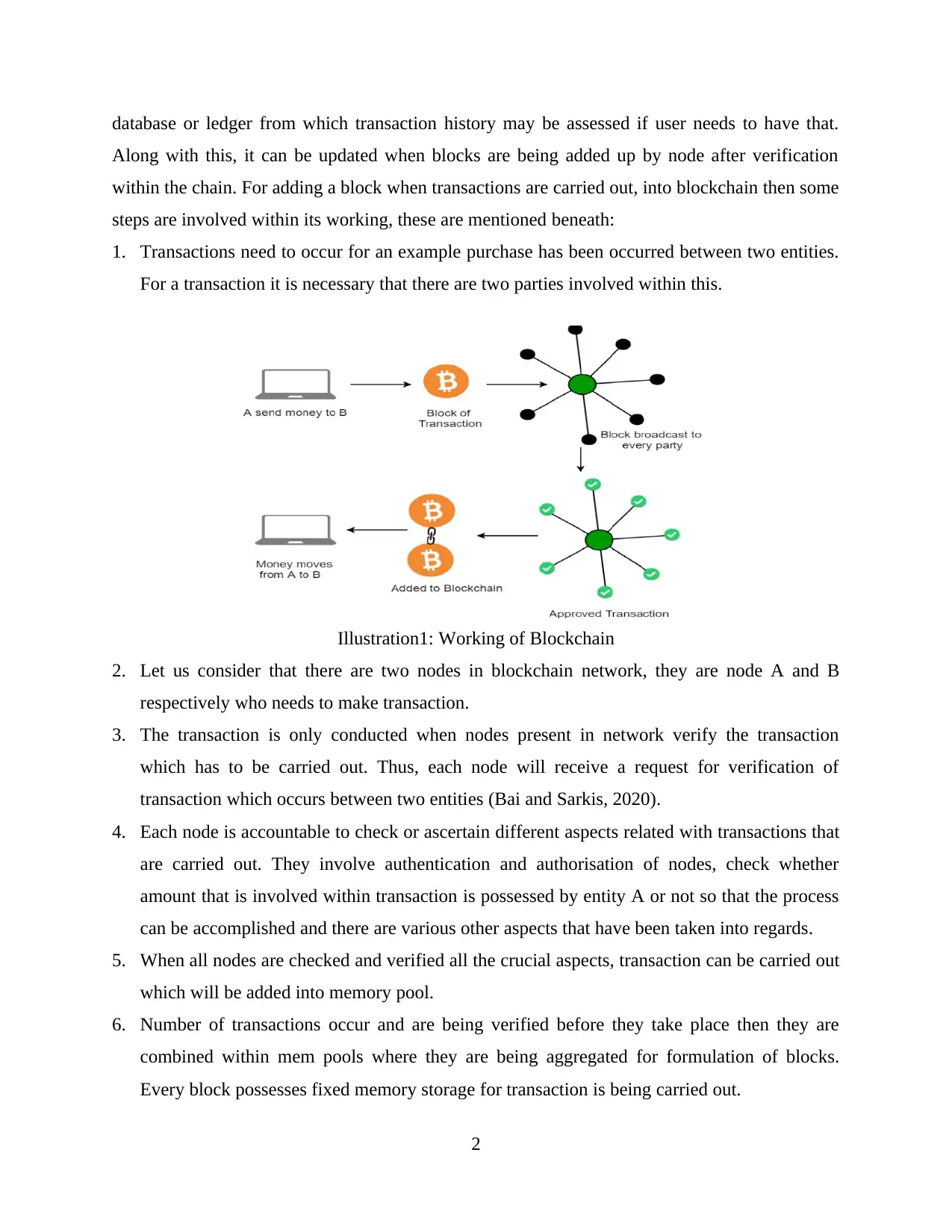
database or ledger from which transaction history may be assessed if user needs to have that.
Along with this, it can be updated when blocks are being added up by node after verification
within the chain. For adding a block when transactions are carried out, into blockchain then some
steps are involved within its working, these are mentioned beneath:
1. Transactions need to occur for an example purchase has been occurred between two entities.
For a transaction it is necessary that there are two parties involved within this.
Illustration1: Working of Blockchain
2. Let us consider that there are two nodes in blockchain network, they are node A and B
respectively who needs to make transaction.
3. The transaction is only conducted when nodes present in network verify the transaction
which has to be carried out. Thus, each node will receive a request for verification of
transaction which occurs between two entities (Bai and Sarkis, 2020).
4. Each node is accountable to check or ascertain different aspects related with transactions that
are carried out. They involve authentication and authorisation of nodes, check whether
amount that is involved within transaction is possessed by entity A or not so that the process
can be accomplished and there are various other aspects that have been taken into regards.
5. When all nodes are checked and verified all the crucial aspects, transaction can be carried out
which will be added into memory pool.
6. Number of transactions occur and are being verified before they take place then they are
combined within mem pools where they are being aggregated for formulation of blocks.
Every block possesses fixed memory storage for transaction is being carried out.
2
Along with this, it can be updated when blocks are being added up by node after verification
within the chain. For adding a block when transactions are carried out, into blockchain then some
steps are involved within its working, these are mentioned beneath:
1. Transactions need to occur for an example purchase has been occurred between two entities.
For a transaction it is necessary that there are two parties involved within this.
Illustration1: Working of Blockchain
2. Let us consider that there are two nodes in blockchain network, they are node A and B
respectively who needs to make transaction.
3. The transaction is only conducted when nodes present in network verify the transaction
which has to be carried out. Thus, each node will receive a request for verification of
transaction which occurs between two entities (Bai and Sarkis, 2020).
4. Each node is accountable to check or ascertain different aspects related with transactions that
are carried out. They involve authentication and authorisation of nodes, check whether
amount that is involved within transaction is possessed by entity A or not so that the process
can be accomplished and there are various other aspects that have been taken into regards.
5. When all nodes are checked and verified all the crucial aspects, transaction can be carried out
which will be added into memory pool.
6. Number of transactions occur and are being verified before they take place then they are
combined within mem pools where they are being aggregated for formulation of blocks.
Every block possesses fixed memory storage for transaction is being carried out.
2
Paraphrase This Document
Need a fresh take? Get an instant paraphrase of this document with our AI Paraphraser
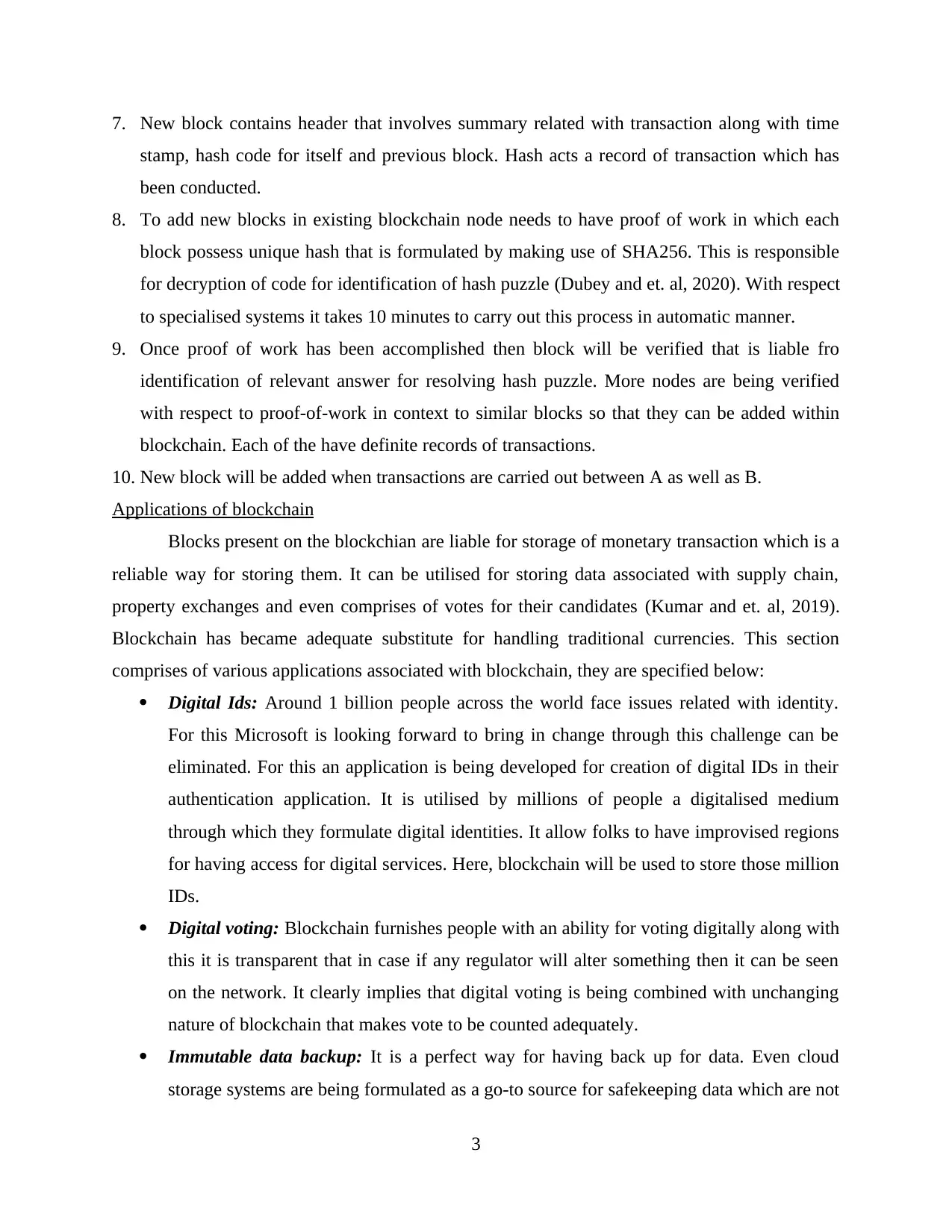
7. New block contains header that involves summary related with transaction along with time
stamp, hash code for itself and previous block. Hash acts a record of transaction which has
been conducted.
8. To add new blocks in existing blockchain node needs to have proof of work in which each
block possess unique hash that is formulated by making use of SHA256. This is responsible
for decryption of code for identification of hash puzzle (Dubey and et. al, 2020). With respect
to specialised systems it takes 10 minutes to carry out this process in automatic manner.
9. Once proof of work has been accomplished then block will be verified that is liable fro
identification of relevant answer for resolving hash puzzle. More nodes are being verified
with respect to proof-of-work in context to similar blocks so that they can be added within
blockchain. Each of the have definite records of transactions.
10. New block will be added when transactions are carried out between A as well as B.
Applications of blockchain
Blocks present on the blockchian are liable for storage of monetary transaction which is a
reliable way for storing them. It can be utilised for storing data associated with supply chain,
property exchanges and even comprises of votes for their candidates (Kumar and et. al, 2019).
Blockchain has became adequate substitute for handling traditional currencies. This section
comprises of various applications associated with blockchain, they are specified below:
Digital Ids: Around 1 billion people across the world face issues related with identity.
For this Microsoft is looking forward to bring in change through this challenge can be
eliminated. For this an application is being developed for creation of digital IDs in their
authentication application. It is utilised by millions of people a digitalised medium
through which they formulate digital identities. It allow folks to have improvised regions
for having access for digital services. Here, blockchain will be used to store those million
IDs.
Digital voting: Blockchain furnishes people with an ability for voting digitally along with
this it is transparent that in case if any regulator will alter something then it can be seen
on the network. It clearly implies that digital voting is being combined with unchanging
nature of blockchain that makes vote to be counted adequately.
Immutable data backup: It is a perfect way for having back up for data. Even cloud
storage systems are being formulated as a go-to source for safekeeping data which are not
3
stamp, hash code for itself and previous block. Hash acts a record of transaction which has
been conducted.
8. To add new blocks in existing blockchain node needs to have proof of work in which each
block possess unique hash that is formulated by making use of SHA256. This is responsible
for decryption of code for identification of hash puzzle (Dubey and et. al, 2020). With respect
to specialised systems it takes 10 minutes to carry out this process in automatic manner.
9. Once proof of work has been accomplished then block will be verified that is liable fro
identification of relevant answer for resolving hash puzzle. More nodes are being verified
with respect to proof-of-work in context to similar blocks so that they can be added within
blockchain. Each of the have definite records of transactions.
10. New block will be added when transactions are carried out between A as well as B.
Applications of blockchain
Blocks present on the blockchian are liable for storage of monetary transaction which is a
reliable way for storing them. It can be utilised for storing data associated with supply chain,
property exchanges and even comprises of votes for their candidates (Kumar and et. al, 2019).
Blockchain has became adequate substitute for handling traditional currencies. This section
comprises of various applications associated with blockchain, they are specified below:
Digital Ids: Around 1 billion people across the world face issues related with identity.
For this Microsoft is looking forward to bring in change through this challenge can be
eliminated. For this an application is being developed for creation of digital IDs in their
authentication application. It is utilised by millions of people a digitalised medium
through which they formulate digital identities. It allow folks to have improvised regions
for having access for digital services. Here, blockchain will be used to store those million
IDs.
Digital voting: Blockchain furnishes people with an ability for voting digitally along with
this it is transparent that in case if any regulator will alter something then it can be seen
on the network. It clearly implies that digital voting is being combined with unchanging
nature of blockchain that makes vote to be counted adequately.
Immutable data backup: It is a perfect way for having back up for data. Even cloud
storage systems are being formulated as a go-to source for safekeeping data which are not
3
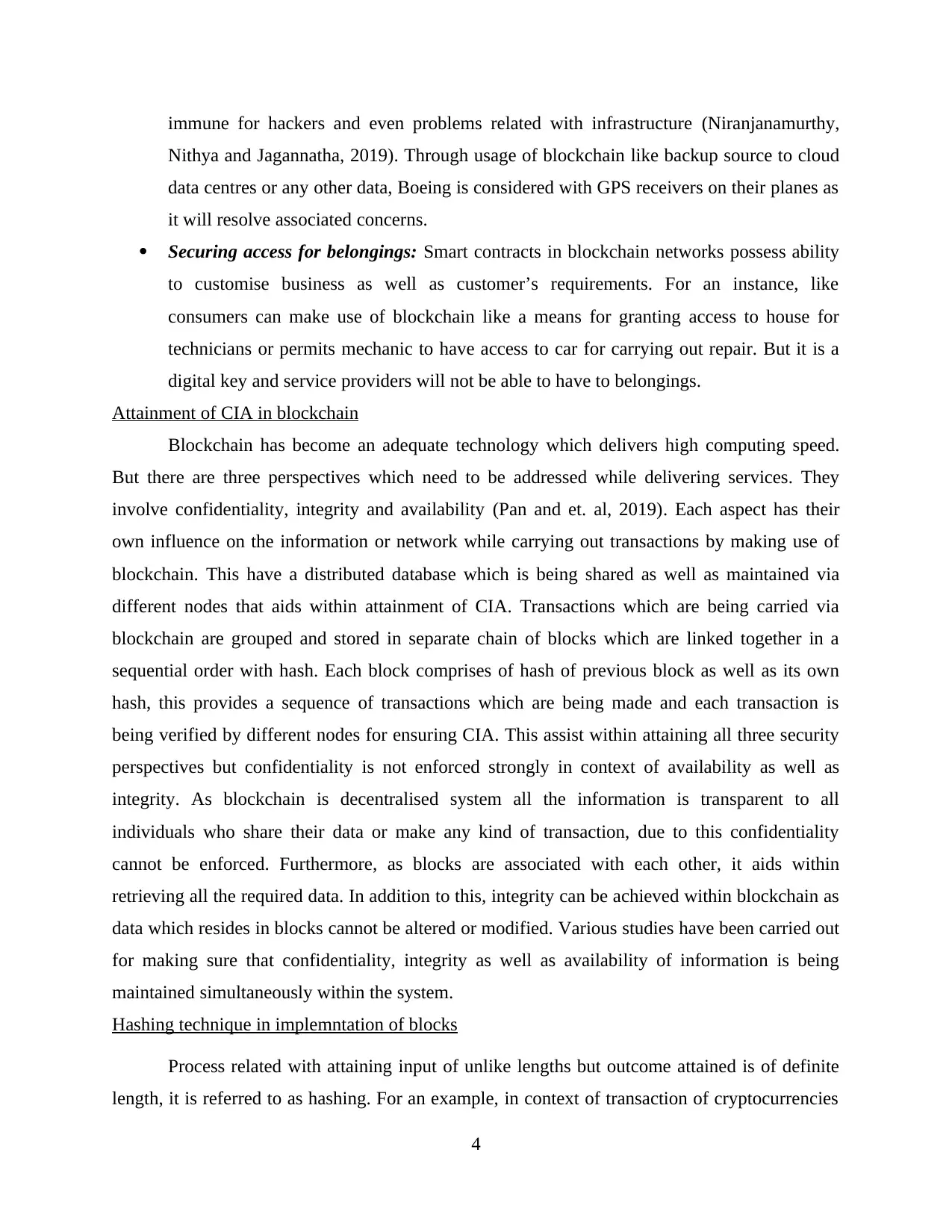
immune for hackers and even problems related with infrastructure (Niranjanamurthy,
Nithya and Jagannatha, 2019). Through usage of blockchain like backup source to cloud
data centres or any other data, Boeing is considered with GPS receivers on their planes as
it will resolve associated concerns.
Securing access for belongings: Smart contracts in blockchain networks possess ability
to customise business as well as customer’s requirements. For an instance, like
consumers can make use of blockchain like a means for granting access to house for
technicians or permits mechanic to have access to car for carrying out repair. But it is a
digital key and service providers will not be able to have to belongings.
Attainment of CIA in blockchain
Blockchain has become an adequate technology which delivers high computing speed.
But there are three perspectives which need to be addressed while delivering services. They
involve confidentiality, integrity and availability (Pan and et. al, 2019). Each aspect has their
own influence on the information or network while carrying out transactions by making use of
blockchain. This have a distributed database which is being shared as well as maintained via
different nodes that aids within attainment of CIA. Transactions which are being carried via
blockchain are grouped and stored in separate chain of blocks which are linked together in a
sequential order with hash. Each block comprises of hash of previous block as well as its own
hash, this provides a sequence of transactions which are being made and each transaction is
being verified by different nodes for ensuring CIA. This assist within attaining all three security
perspectives but confidentiality is not enforced strongly in context of availability as well as
integrity. As blockchain is decentralised system all the information is transparent to all
individuals who share their data or make any kind of transaction, due to this confidentiality
cannot be enforced. Furthermore, as blocks are associated with each other, it aids within
retrieving all the required data. In addition to this, integrity can be achieved within blockchain as
data which resides in blocks cannot be altered or modified. Various studies have been carried out
for making sure that confidentiality, integrity as well as availability of information is being
maintained simultaneously within the system.
Hashing technique in implemntation of blocks
Process related with attaining input of unlike lengths but outcome attained is of definite
length, it is referred to as hashing. For an example, in context of transaction of cryptocurrencies
4
Nithya and Jagannatha, 2019). Through usage of blockchain like backup source to cloud
data centres or any other data, Boeing is considered with GPS receivers on their planes as
it will resolve associated concerns.
Securing access for belongings: Smart contracts in blockchain networks possess ability
to customise business as well as customer’s requirements. For an instance, like
consumers can make use of blockchain like a means for granting access to house for
technicians or permits mechanic to have access to car for carrying out repair. But it is a
digital key and service providers will not be able to have to belongings.
Attainment of CIA in blockchain
Blockchain has become an adequate technology which delivers high computing speed.
But there are three perspectives which need to be addressed while delivering services. They
involve confidentiality, integrity and availability (Pan and et. al, 2019). Each aspect has their
own influence on the information or network while carrying out transactions by making use of
blockchain. This have a distributed database which is being shared as well as maintained via
different nodes that aids within attainment of CIA. Transactions which are being carried via
blockchain are grouped and stored in separate chain of blocks which are linked together in a
sequential order with hash. Each block comprises of hash of previous block as well as its own
hash, this provides a sequence of transactions which are being made and each transaction is
being verified by different nodes for ensuring CIA. This assist within attaining all three security
perspectives but confidentiality is not enforced strongly in context of availability as well as
integrity. As blockchain is decentralised system all the information is transparent to all
individuals who share their data or make any kind of transaction, due to this confidentiality
cannot be enforced. Furthermore, as blocks are associated with each other, it aids within
retrieving all the required data. In addition to this, integrity can be achieved within blockchain as
data which resides in blocks cannot be altered or modified. Various studies have been carried out
for making sure that confidentiality, integrity as well as availability of information is being
maintained simultaneously within the system.
Hashing technique in implemntation of blocks
Process related with attaining input of unlike lengths but outcome attained is of definite
length, it is referred to as hashing. For an example, in context of transaction of cryptocurrencies
4
⊘ This is a preview!⊘
Do you want full access?
Subscribe today to unlock all pages.

Trusted by 1+ million students worldwide
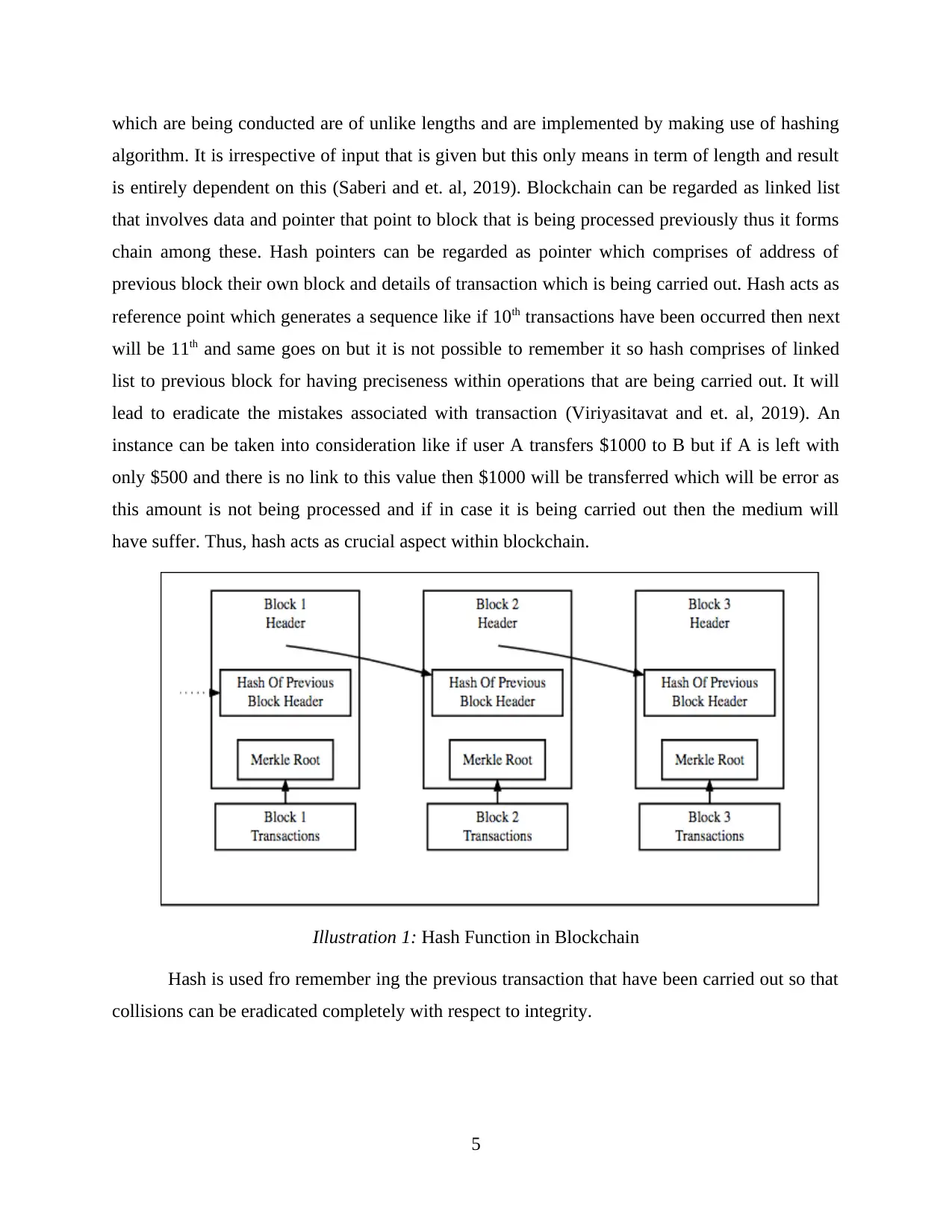
which are being conducted are of unlike lengths and are implemented by making use of hashing
algorithm. It is irrespective of input that is given but this only means in term of length and result
is entirely dependent on this (Saberi and et. al, 2019). Blockchain can be regarded as linked list
that involves data and pointer that point to block that is being processed previously thus it forms
chain among these. Hash pointers can be regarded as pointer which comprises of address of
previous block their own block and details of transaction which is being carried out. Hash acts as
reference point which generates a sequence like if 10th transactions have been occurred then next
will be 11th and same goes on but it is not possible to remember it so hash comprises of linked
list to previous block for having preciseness within operations that are being carried out. It will
lead to eradicate the mistakes associated with transaction (Viriyasitavat and et. al, 2019). An
instance can be taken into consideration like if user A transfers $1000 to B but if A is left with
only $500 and there is no link to this value then $1000 will be transferred which will be error as
this amount is not being processed and if in case it is being carried out then the medium will
have suffer. Thus, hash acts as crucial aspect within blockchain.
Illustration 1: Hash Function in Blockchain
Hash is used fro remember ing the previous transaction that have been carried out so that
collisions can be eradicated completely with respect to integrity.
5
algorithm. It is irrespective of input that is given but this only means in term of length and result
is entirely dependent on this (Saberi and et. al, 2019). Blockchain can be regarded as linked list
that involves data and pointer that point to block that is being processed previously thus it forms
chain among these. Hash pointers can be regarded as pointer which comprises of address of
previous block their own block and details of transaction which is being carried out. Hash acts as
reference point which generates a sequence like if 10th transactions have been occurred then next
will be 11th and same goes on but it is not possible to remember it so hash comprises of linked
list to previous block for having preciseness within operations that are being carried out. It will
lead to eradicate the mistakes associated with transaction (Viriyasitavat and et. al, 2019). An
instance can be taken into consideration like if user A transfers $1000 to B but if A is left with
only $500 and there is no link to this value then $1000 will be transferred which will be error as
this amount is not being processed and if in case it is being carried out then the medium will
have suffer. Thus, hash acts as crucial aspect within blockchain.
Illustration 1: Hash Function in Blockchain
Hash is used fro remember ing the previous transaction that have been carried out so that
collisions can be eradicated completely with respect to integrity.
5
Paraphrase This Document
Need a fresh take? Get an instant paraphrase of this document with our AI Paraphraser
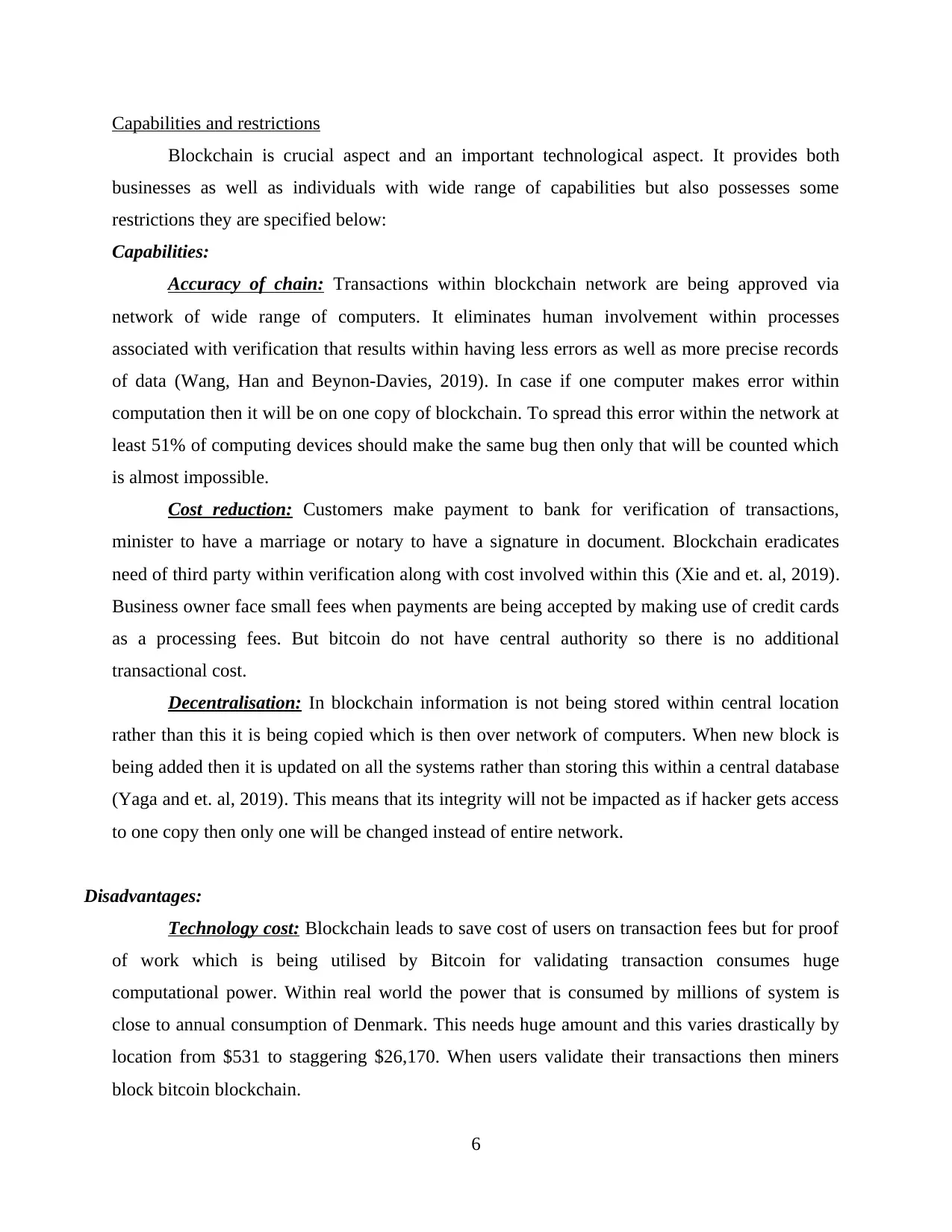
Capabilities and restrictions
Blockchain is crucial aspect and an important technological aspect. It provides both
businesses as well as individuals with wide range of capabilities but also possesses some
restrictions they are specified below:
Capabilities:
Accuracy of chain: Transactions within blockchain network are being approved via
network of wide range of computers. It eliminates human involvement within processes
associated with verification that results within having less errors as well as more precise records
of data (Wang, Han and Beynon-Davies, 2019). In case if one computer makes error within
computation then it will be on one copy of blockchain. To spread this error within the network at
least 51% of computing devices should make the same bug then only that will be counted which
is almost impossible.
Cost reduction: Customers make payment to bank for verification of transactions,
minister to have a marriage or notary to have a signature in document. Blockchain eradicates
need of third party within verification along with cost involved within this (Xie and et. al, 2019).
Business owner face small fees when payments are being accepted by making use of credit cards
as a processing fees. But bitcoin do not have central authority so there is no additional
transactional cost.
Decentralisation: In blockchain information is not being stored within central location
rather than this it is being copied which is then over network of computers. When new block is
being added then it is updated on all the systems rather than storing this within a central database
(Yaga and et. al, 2019). This means that its integrity will not be impacted as if hacker gets access
to one copy then only one will be changed instead of entire network.
Disadvantages:
Technology cost: Blockchain leads to save cost of users on transaction fees but for proof
of work which is being utilised by Bitcoin for validating transaction consumes huge
computational power. Within real world the power that is consumed by millions of system is
close to annual consumption of Denmark. This needs huge amount and this varies drastically by
location from $531 to staggering $26,170. When users validate their transactions then miners
block bitcoin blockchain.
6
Blockchain is crucial aspect and an important technological aspect. It provides both
businesses as well as individuals with wide range of capabilities but also possesses some
restrictions they are specified below:
Capabilities:
Accuracy of chain: Transactions within blockchain network are being approved via
network of wide range of computers. It eliminates human involvement within processes
associated with verification that results within having less errors as well as more precise records
of data (Wang, Han and Beynon-Davies, 2019). In case if one computer makes error within
computation then it will be on one copy of blockchain. To spread this error within the network at
least 51% of computing devices should make the same bug then only that will be counted which
is almost impossible.
Cost reduction: Customers make payment to bank for verification of transactions,
minister to have a marriage or notary to have a signature in document. Blockchain eradicates
need of third party within verification along with cost involved within this (Xie and et. al, 2019).
Business owner face small fees when payments are being accepted by making use of credit cards
as a processing fees. But bitcoin do not have central authority so there is no additional
transactional cost.
Decentralisation: In blockchain information is not being stored within central location
rather than this it is being copied which is then over network of computers. When new block is
being added then it is updated on all the systems rather than storing this within a central database
(Yaga and et. al, 2019). This means that its integrity will not be impacted as if hacker gets access
to one copy then only one will be changed instead of entire network.
Disadvantages:
Technology cost: Blockchain leads to save cost of users on transaction fees but for proof
of work which is being utilised by Bitcoin for validating transaction consumes huge
computational power. Within real world the power that is consumed by millions of system is
close to annual consumption of Denmark. This needs huge amount and this varies drastically by
location from $531 to staggering $26,170. When users validate their transactions then miners
block bitcoin blockchain.
6
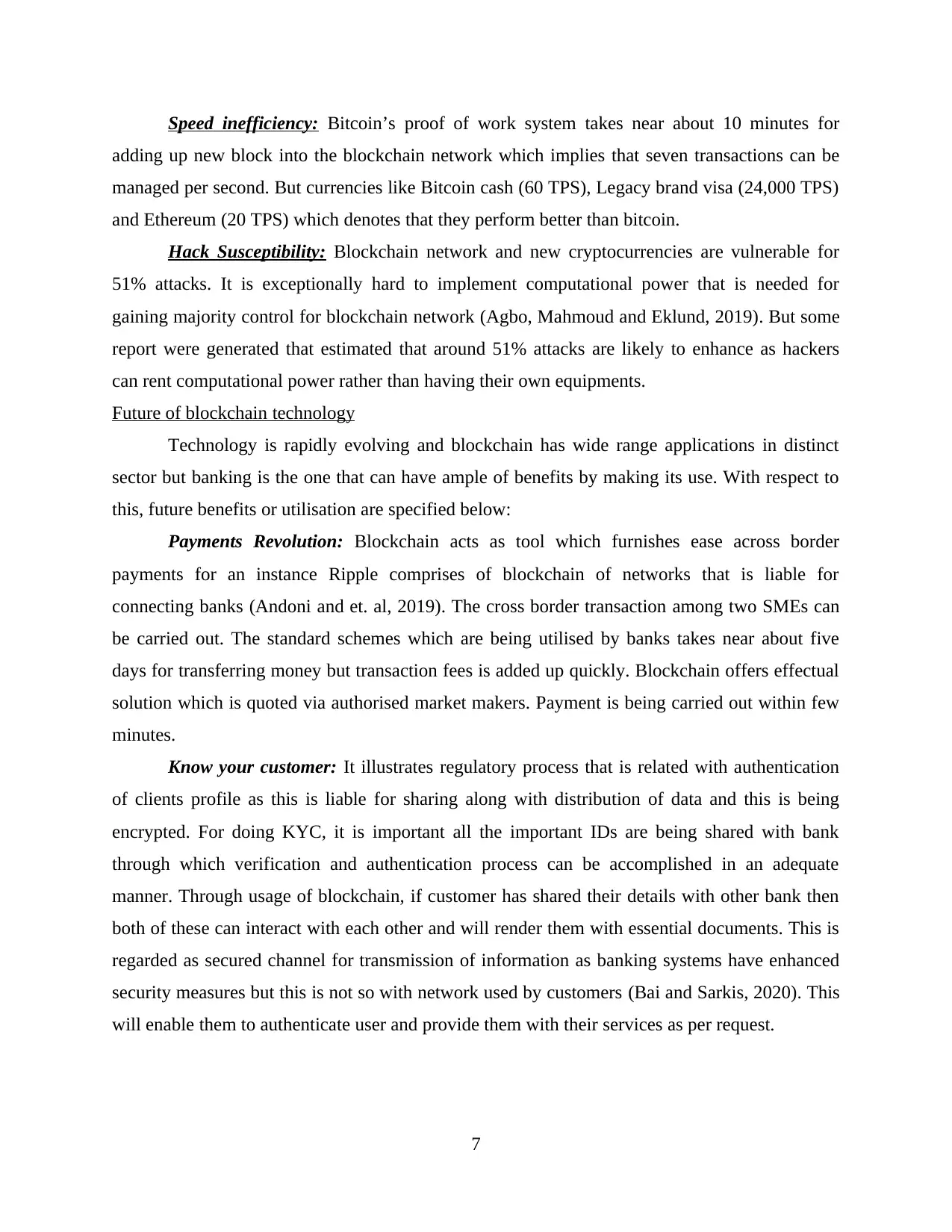
Speed inefficiency: Bitcoin’s proof of work system takes near about 10 minutes for
adding up new block into the blockchain network which implies that seven transactions can be
managed per second. But currencies like Bitcoin cash (60 TPS), Legacy brand visa (24,000 TPS)
and Ethereum (20 TPS) which denotes that they perform better than bitcoin.
Hack Susceptibility: Blockchain network and new cryptocurrencies are vulnerable for
51% attacks. It is exceptionally hard to implement computational power that is needed for
gaining majority control for blockchain network (Agbo, Mahmoud and Eklund, 2019). But some
report were generated that estimated that around 51% attacks are likely to enhance as hackers
can rent computational power rather than having their own equipments.
Future of blockchain technology
Technology is rapidly evolving and blockchain has wide range applications in distinct
sector but banking is the one that can have ample of benefits by making its use. With respect to
this, future benefits or utilisation are specified below:
Payments Revolution: Blockchain acts as tool which furnishes ease across border
payments for an instance Ripple comprises of blockchain of networks that is liable for
connecting banks (Andoni and et. al, 2019). The cross border transaction among two SMEs can
be carried out. The standard schemes which are being utilised by banks takes near about five
days for transferring money but transaction fees is added up quickly. Blockchain offers effectual
solution which is quoted via authorised market makers. Payment is being carried out within few
minutes.
Know your customer: It illustrates regulatory process that is related with authentication
of clients profile as this is liable for sharing along with distribution of data and this is being
encrypted. For doing KYC, it is important all the important IDs are being shared with bank
through which verification and authentication process can be accomplished in an adequate
manner. Through usage of blockchain, if customer has shared their details with other bank then
both of these can interact with each other and will render them with essential documents. This is
regarded as secured channel for transmission of information as banking systems have enhanced
security measures but this is not so with network used by customers (Bai and Sarkis, 2020). This
will enable them to authenticate user and provide them with their services as per request.
7
adding up new block into the blockchain network which implies that seven transactions can be
managed per second. But currencies like Bitcoin cash (60 TPS), Legacy brand visa (24,000 TPS)
and Ethereum (20 TPS) which denotes that they perform better than bitcoin.
Hack Susceptibility: Blockchain network and new cryptocurrencies are vulnerable for
51% attacks. It is exceptionally hard to implement computational power that is needed for
gaining majority control for blockchain network (Agbo, Mahmoud and Eklund, 2019). But some
report were generated that estimated that around 51% attacks are likely to enhance as hackers
can rent computational power rather than having their own equipments.
Future of blockchain technology
Technology is rapidly evolving and blockchain has wide range applications in distinct
sector but banking is the one that can have ample of benefits by making its use. With respect to
this, future benefits or utilisation are specified below:
Payments Revolution: Blockchain acts as tool which furnishes ease across border
payments for an instance Ripple comprises of blockchain of networks that is liable for
connecting banks (Andoni and et. al, 2019). The cross border transaction among two SMEs can
be carried out. The standard schemes which are being utilised by banks takes near about five
days for transferring money but transaction fees is added up quickly. Blockchain offers effectual
solution which is quoted via authorised market makers. Payment is being carried out within few
minutes.
Know your customer: It illustrates regulatory process that is related with authentication
of clients profile as this is liable for sharing along with distribution of data and this is being
encrypted. For doing KYC, it is important all the important IDs are being shared with bank
through which verification and authentication process can be accomplished in an adequate
manner. Through usage of blockchain, if customer has shared their details with other bank then
both of these can interact with each other and will render them with essential documents. This is
regarded as secured channel for transmission of information as banking systems have enhanced
security measures but this is not so with network used by customers (Bai and Sarkis, 2020). This
will enable them to authenticate user and provide them with their services as per request.
7
⊘ This is a preview!⊘
Do you want full access?
Subscribe today to unlock all pages.

Trusted by 1+ million students worldwide
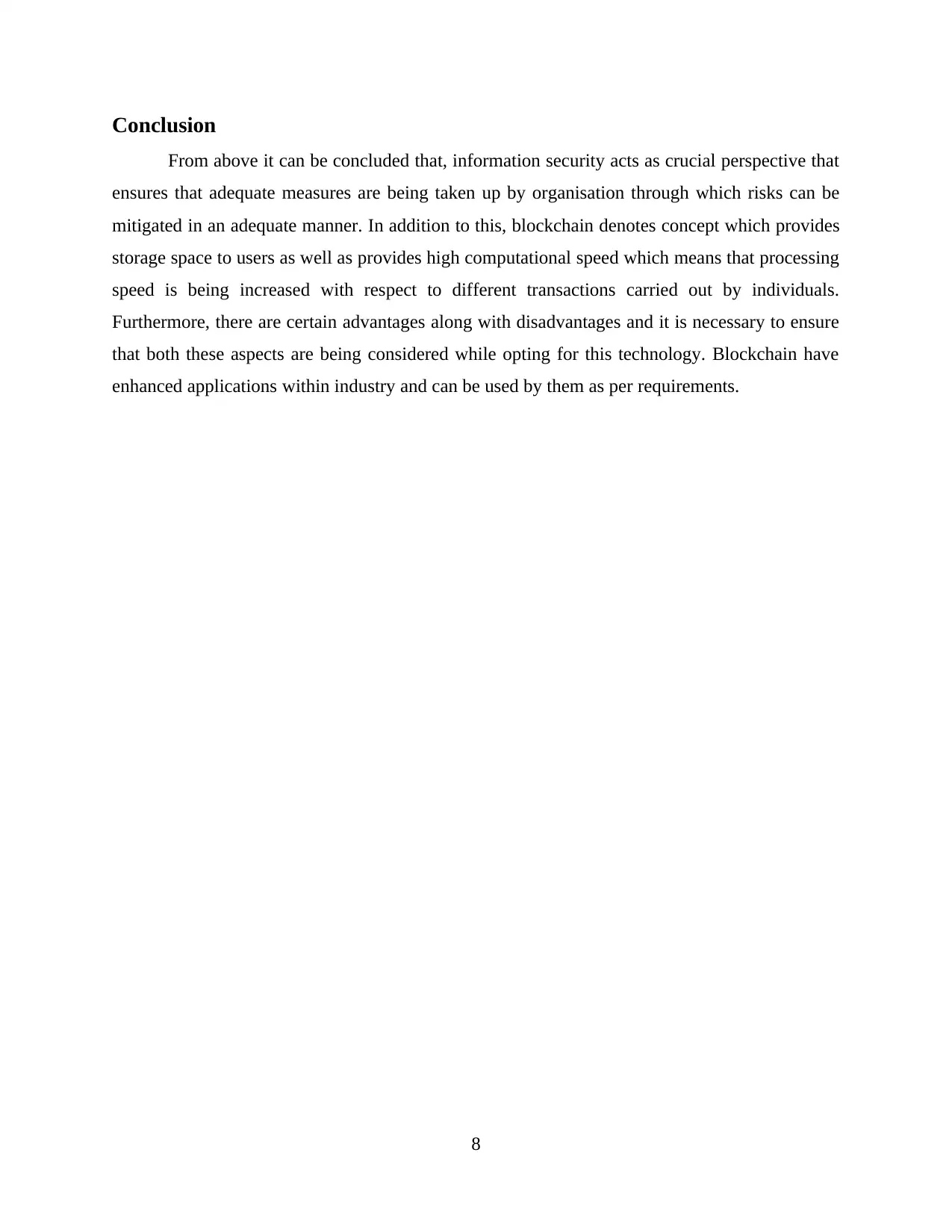
Conclusion
From above it can be concluded that, information security acts as crucial perspective that
ensures that adequate measures are being taken up by organisation through which risks can be
mitigated in an adequate manner. In addition to this, blockchain denotes concept which provides
storage space to users as well as provides high computational speed which means that processing
speed is being increased with respect to different transactions carried out by individuals.
Furthermore, there are certain advantages along with disadvantages and it is necessary to ensure
that both these aspects are being considered while opting for this technology. Blockchain have
enhanced applications within industry and can be used by them as per requirements.
8
From above it can be concluded that, information security acts as crucial perspective that
ensures that adequate measures are being taken up by organisation through which risks can be
mitigated in an adequate manner. In addition to this, blockchain denotes concept which provides
storage space to users as well as provides high computational speed which means that processing
speed is being increased with respect to different transactions carried out by individuals.
Furthermore, there are certain advantages along with disadvantages and it is necessary to ensure
that both these aspects are being considered while opting for this technology. Blockchain have
enhanced applications within industry and can be used by them as per requirements.
8
Paraphrase This Document
Need a fresh take? Get an instant paraphrase of this document with our AI Paraphraser
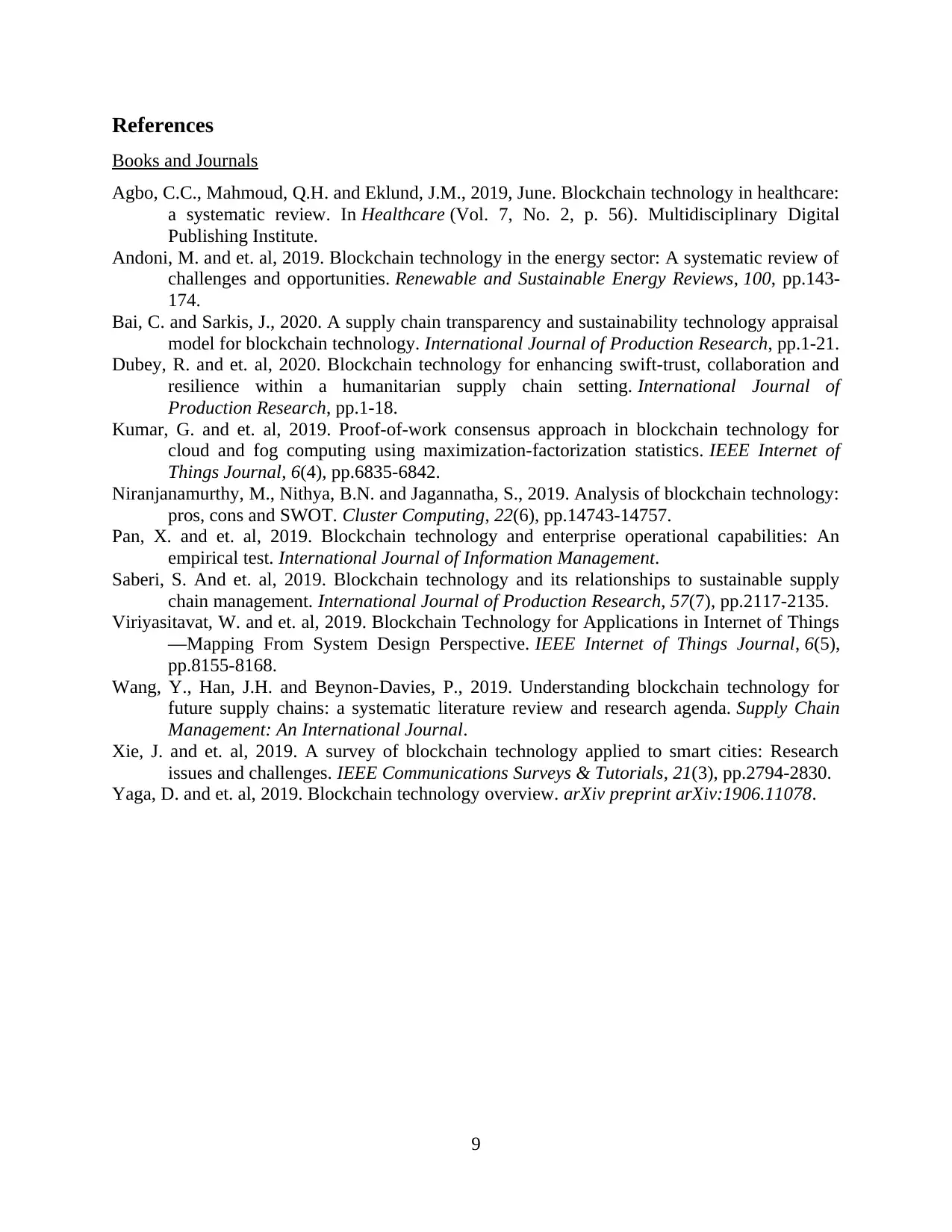
References
Books and Journals
Agbo, C.C., Mahmoud, Q.H. and Eklund, J.M., 2019, June. Blockchain technology in healthcare:
a systematic review. In Healthcare (Vol. 7, No. 2, p. 56). Multidisciplinary Digital
Publishing Institute.
Andoni, M. and et. al, 2019. Blockchain technology in the energy sector: A systematic review of
challenges and opportunities. Renewable and Sustainable Energy Reviews, 100, pp.143-
174.
Bai, C. and Sarkis, J., 2020. A supply chain transparency and sustainability technology appraisal
model for blockchain technology. International Journal of Production Research, pp.1-21.
Dubey, R. and et. al, 2020. Blockchain technology for enhancing swift-trust, collaboration and
resilience within a humanitarian supply chain setting. International Journal of
Production Research, pp.1-18.
Kumar, G. and et. al, 2019. Proof-of-work consensus approach in blockchain technology for
cloud and fog computing using maximization-factorization statistics. IEEE Internet of
Things Journal, 6(4), pp.6835-6842.
Niranjanamurthy, M., Nithya, B.N. and Jagannatha, S., 2019. Analysis of blockchain technology:
pros, cons and SWOT. Cluster Computing, 22(6), pp.14743-14757.
Pan, X. and et. al, 2019. Blockchain technology and enterprise operational capabilities: An
empirical test. International Journal of Information Management.
Saberi, S. And et. al, 2019. Blockchain technology and its relationships to sustainable supply
chain management. International Journal of Production Research, 57(7), pp.2117-2135.
Viriyasitavat, W. and et. al, 2019. Blockchain Technology for Applications in Internet of Things
—Mapping From System Design Perspective. IEEE Internet of Things Journal, 6(5),
pp.8155-8168.
Wang, Y., Han, J.H. and Beynon-Davies, P., 2019. Understanding blockchain technology for
future supply chains: a systematic literature review and research agenda. Supply Chain
Management: An International Journal.
Xie, J. and et. al, 2019. A survey of blockchain technology applied to smart cities: Research
issues and challenges. IEEE Communications Surveys & Tutorials, 21(3), pp.2794-2830.
Yaga, D. and et. al, 2019. Blockchain technology overview. arXiv preprint arXiv:1906.11078.
9
Books and Journals
Agbo, C.C., Mahmoud, Q.H. and Eklund, J.M., 2019, June. Blockchain technology in healthcare:
a systematic review. In Healthcare (Vol. 7, No. 2, p. 56). Multidisciplinary Digital
Publishing Institute.
Andoni, M. and et. al, 2019. Blockchain technology in the energy sector: A systematic review of
challenges and opportunities. Renewable and Sustainable Energy Reviews, 100, pp.143-
174.
Bai, C. and Sarkis, J., 2020. A supply chain transparency and sustainability technology appraisal
model for blockchain technology. International Journal of Production Research, pp.1-21.
Dubey, R. and et. al, 2020. Blockchain technology for enhancing swift-trust, collaboration and
resilience within a humanitarian supply chain setting. International Journal of
Production Research, pp.1-18.
Kumar, G. and et. al, 2019. Proof-of-work consensus approach in blockchain technology for
cloud and fog computing using maximization-factorization statistics. IEEE Internet of
Things Journal, 6(4), pp.6835-6842.
Niranjanamurthy, M., Nithya, B.N. and Jagannatha, S., 2019. Analysis of blockchain technology:
pros, cons and SWOT. Cluster Computing, 22(6), pp.14743-14757.
Pan, X. and et. al, 2019. Blockchain technology and enterprise operational capabilities: An
empirical test. International Journal of Information Management.
Saberi, S. And et. al, 2019. Blockchain technology and its relationships to sustainable supply
chain management. International Journal of Production Research, 57(7), pp.2117-2135.
Viriyasitavat, W. and et. al, 2019. Blockchain Technology for Applications in Internet of Things
—Mapping From System Design Perspective. IEEE Internet of Things Journal, 6(5),
pp.8155-8168.
Wang, Y., Han, J.H. and Beynon-Davies, P., 2019. Understanding blockchain technology for
future supply chains: a systematic literature review and research agenda. Supply Chain
Management: An International Journal.
Xie, J. and et. al, 2019. A survey of blockchain technology applied to smart cities: Research
issues and challenges. IEEE Communications Surveys & Tutorials, 21(3), pp.2794-2830.
Yaga, D. and et. al, 2019. Blockchain technology overview. arXiv preprint arXiv:1906.11078.
9
1 out of 11
Related Documents
Your All-in-One AI-Powered Toolkit for Academic Success.
+13062052269
info@desklib.com
Available 24*7 on WhatsApp / Email
![[object Object]](/_next/static/media/star-bottom.7253800d.svg)
Unlock your academic potential
Copyright © 2020–2025 A2Z Services. All Rights Reserved. Developed and managed by ZUCOL.





